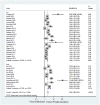Medicaid Patients Have Greater Difficulty Scheduling Health Care Appointments Compared With Private Insurance Patients: A Meta-Analysis
- PMID: 30947608
- PMCID: PMC6452575
- DOI: 10.1177/0046958019838118
Medicaid Patients Have Greater Difficulty Scheduling Health Care Appointments Compared With Private Insurance Patients: A Meta-Analysis
Abstract
Medicaid patients are known to have reduced access to care compared with privately insured patients; however, quantifying this disparity with large controlled studies remains a challenge. This meta-analysis evaluates the disparity in health services accessibility of appointments between Medicaid and privately insured patients through audit studies of health care appointments and schedules. Audit studies evaluating different types of outpatient physician practices were selected. Studies were categorized based on the characteristics of the simulated patient scenario. The relative risk of appointment availability was calculated for all different types of audit scenario characteristics. As a secondary analysis, appointment availability was compared pre- versus post-Medicaid expansion. Overall, 34 audit studies were identified, which demonstrated that Medicaid insurance is associated with a 1.6-fold lower likelihood in successfully scheduling a primary care appointment and a 3.3-fold lower likelihood in successfully scheduling a specialty appointment when compared with private insurance. In this first meta-analysis comparing appointment availability between Medicaid and privately insured patients, we demonstrate Medicaid patients have greater difficulty obtaining appointments compared with privately insured patients across a variety of medical scenarios.
Keywords: Medicaid; appointments and schedules; health services accessibility; healthcare disparities; insurance; meta-analysis; patient protection and affordable care act; primary health care.
Conflict of interest statement
Figures



References
-
- Boccuti C, Fields C, Casillas G, Hamel L. Primary care physicians accepting Medicare: a snapshot. https://www.kff.org/medicare/issue-brief/primary-care-physicians-accepti.... Published October 2015. Accessed March 8, 2019.
-
- Ryan J, Doty M, Hamel L, Norton M, Abrams M, Brodie M. Primary care providers’ views of recent trends in health care delivery and payment. https://www.commonwealthfund.org/publications/issue-briefs/2015/aug/prim.... Published August 2015. Accessed March 8, 2019.
-
- Penchansky R, Thomas JW. The concept of access: definition and relationship to consumer satisfaction. Med Care. 1981;19(2):127-140. - PubMed
-
- Frenk J. Concept and measurement of accessibility. Salud Publica Mex. 1985;27(5):438-453. - PubMed
-
- Hall AG, Lemak CH, Steingraber H, Schaffer S. Expanding the definition of access: it isn’t just about health insurance. J Health Care Poor Underserved. 2008;19(2):625-638. - PubMed
Publication types
MeSH terms
LinkOut - more resources
Full Text Sources
Medical
Research Materials

